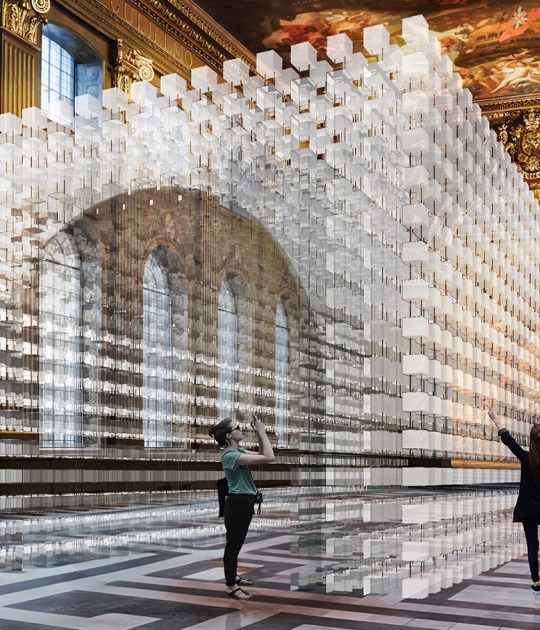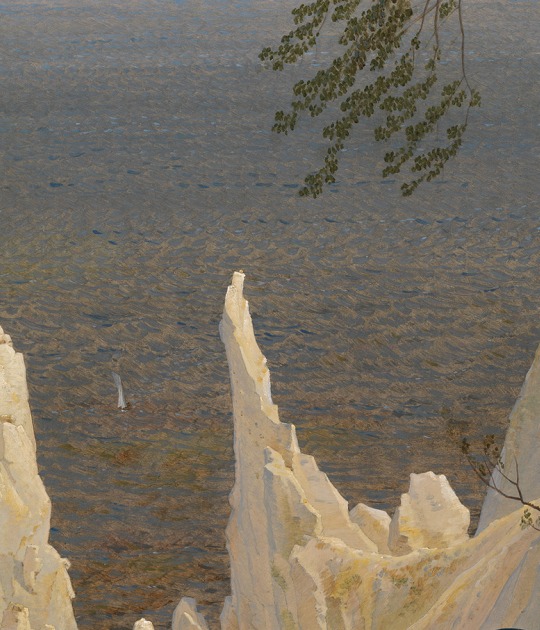The artistic movement that in Spain is called hyperrealism was born in the United States in the 1960s as a drift from Pop Art and was baptized as Photorealism by gallery owner Louis K. Meisel. Based on the pictorial reproduction of photographic originals, hyperrealism refers us at the same time to great precedents in the history of art. The landscapes, often panoramic views of cities or suburban settings, connect with the tradition of 18th-century Italian vedutismo. In still life, the dominant references are 17th-century Dutch still life and late 19th-century American trompe l'oeil painting.
This exhibition opens with two New York views, a more classic one (People's Flowers, 1971) and a more recent one (Self-Portrait near the Oculus at the World Trade Center, 2017) of the most iconic representative of American hyperrealism, Richard Estes (1932), to which our museum dedicated a retrospective in 2007. Charles Bell (1935-1995) belongs, like Estes, to the first generation of the movement. His still lifes nostalgically evoke the world of childhood: his favourite subjects are old tin toys, marbles, gumball machines, and pinball machines, such as the one included here (Tropical Nights, 1991).

Bunny in the corner, 2019. Oil on canvas, 57,2 x 57,2 cm © Roberto Bernardi. Courtesy Louis K. Meisel Gallery, NY. Courtesy of Museo Nacional Thyssen-Bornemisza
An outstanding member of the second generation of American photorealism, Don Jacot (1949-2021) became known in the 1980s for landscapes of his native Chicago; he then frequented, like Bell, still lifes with vintage toys, to return at the end of his career to urban views, such as the one included in this exhibition (La 49 con Broadway, 2019).
Both Bertrand Meniel (1961) and Roberto Bernardi (1974) and Raphaella Spence (1978) belong to the latest generations of hyperrealism, which has now become a fully international movement. Bertrand Meniel cultivates the urban landscape; Lucky Dragon (2009) represents a corner of Chinatown in San Francisco, combining the closest and most everyday picturesque (the Chinese bazaar) with a recognizable monumental landmark (the Transamerica Pyramid in the background). Roberto Bernardi's speciality is still lifes, colourful and brilliant, of glass objects and sweets (Bunny in the corner, 2019). The two paintings by Raphaella Spence escape the usual themes of the hyperrealist repertoire to show us the exuberant vitality of nature (The Path, 2019) and the alarming deterioration of the environment (Schweppes, 2022).
This exhibition opens with two New York views, a more classic one (People's Flowers, 1971) and a more recent one (Self-Portrait near the Oculus at the World Trade Center, 2017) of the most iconic representative of American hyperrealism, Richard Estes (1932), to which our museum dedicated a retrospective in 2007. Charles Bell (1935-1995) belongs, like Estes, to the first generation of the movement. His still lifes nostalgically evoke the world of childhood: his favourite subjects are old tin toys, marbles, gumball machines, and pinball machines, such as the one included here (Tropical Nights, 1991).

Bunny in the corner, 2019. Oil on canvas, 57,2 x 57,2 cm © Roberto Bernardi. Courtesy Louis K. Meisel Gallery, NY. Courtesy of Museo Nacional Thyssen-Bornemisza
An outstanding member of the second generation of American photorealism, Don Jacot (1949-2021) became known in the 1980s for landscapes of his native Chicago; he then frequented, like Bell, still lifes with vintage toys, to return at the end of his career to urban views, such as the one included in this exhibition (La 49 con Broadway, 2019).
Both Bertrand Meniel (1961) and Roberto Bernardi (1974) and Raphaella Spence (1978) belong to the latest generations of hyperrealism, which has now become a fully international movement. Bertrand Meniel cultivates the urban landscape; Lucky Dragon (2009) represents a corner of Chinatown in San Francisco, combining the closest and most everyday picturesque (the Chinese bazaar) with a recognizable monumental landmark (the Transamerica Pyramid in the background). Roberto Bernardi's speciality is still lifes, colourful and brilliant, of glass objects and sweets (Bunny in the corner, 2019). The two paintings by Raphaella Spence escape the usual themes of the hyperrealist repertoire to show us the exuberant vitality of nature (The Path, 2019) and the alarming deterioration of the environment (Schweppes, 2022).



























